Pho is probably the most popular dish of Vietnam. Noodle soups are extremely popular throughout the Far East, but Vietnam is known for its distinctive flavors.
Beef Broth
To start, make a beef broth. You might want to refer back to this post: Ox Feet Broth, Miso Soup, and Other Soups. It’s not necessary to start from ox feet, any beef bones will do. It’s nice to choose bones that have a lot of collagen and fat, that makes a richer broth.
Beef bones are available at a wide range of stores these days. To make our broth, we picked up $3 of beef bones at BJ’s Wholesale Club yesterday and cooked them in water for 3 hours. Today, before dinner, we warmed up a portion. Here’s what it looks like:
Rice Noodles
You’ll also need some rice noodles. We discussed rice noodles in this post: Cranky Grouch’s Spaghetti. The chief difference from that recipe is that we used thinner noodles, so it took less than 3 minutes to cook the noodles. As before, it’s important to have the water reach a boil before adding the noodles, cook briefly, and then drain the water and cool the noodles in cold water to stop them from cooking further. Another difference is that we didn’t add olive oil at the end.
Here’s a picture of today’s rice noodles cooking:
Other Ingredients
The essential ingredients are thin-sliced beef, fish sauce, a lime, and basil leaves. (You can substitute cooked shredded chicken or shrimp for beef.)
Other standard ingredients are bean sprouts (which are legumes, but low in toxicity and more like a vegetable) and cilantro. We think red onions complement the other flavors.
Some spices may also be desired, but are not necessary. Chili sauce for those who like it hot, plum sauce for those who like it sweet. Black bean sauce, garlic, ginger, salt, and pepper are also commonly used.
Thin-sliced beef is readily available at Asian markets. It’s often labeled as beef for shabu-shabu, the Japanese version of hot pot:
Here is the fish sauce and chili sauce we used. We prefer lighter fish sauces, which are translucent in the bottle; stronger fish sauces are opaque.
Here are the ingredients we used:
The lime is cut into eighths, the beef thawed; that is fish sauce on the lower left.
Making Your Pho
You can arrange the ingredients to your taste in your own soup bowl. Paul starts with some noodles, onions, and thin-sliced beef:
The broth is added hot from the pot, and the thin beef slices change color to brown within seconds. Top with sprouts and basil, and it looks like this:
Add lime, fish sauce, and spices to taste, and you’re ready to go. Here Paul has lifted out a piece of collagen and fat from the broth – this adds great richness to the soup:
It was delicious! The lime and fish sauce flavor is unique to Vietnamese cuisine and makes a great change of pace from our regular cooking.
If Chef Anthony Bourdain had come to dinner with us tonight, he might have been even more delighted than he was in this video:







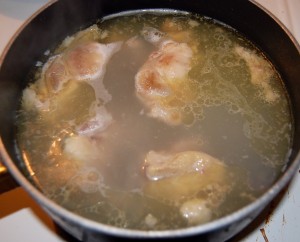
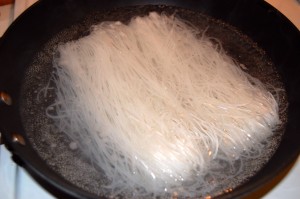
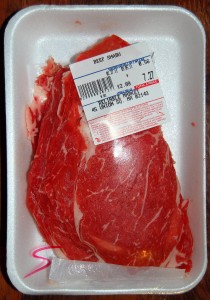
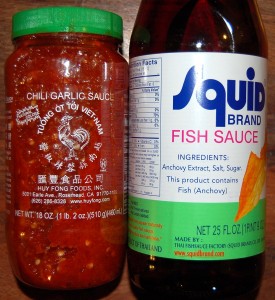
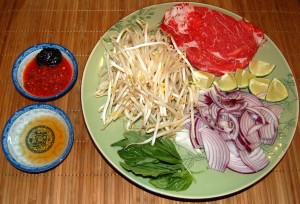
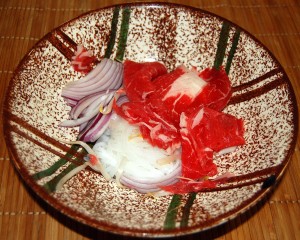
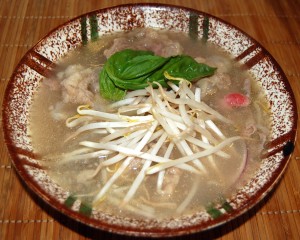
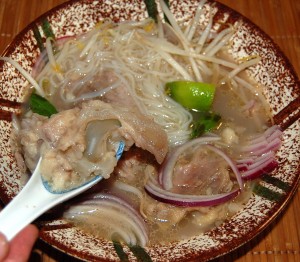




Mint leaves are a wonderful substitute for the basil.
Yes! Thank you Erich!
Thanks, this looks great and easy to do! One of my coworkers has recently introduced me to Pho and this will be great to try out on my own.
Yum! I’ll have to try that. I used to love Pho back in my neolithic past.
I think it is far better to eat pho at a restaurant than make it.
In fact that is usually my benchmark for fast food; is the food easier to make in a restaurant than it is at home?
Pho is also not as filling as I imagine. Usually hungry an hour later. I usually only get the tai meat, but I’m sure Paul wants us to get the tripe and or liver options.
Hi Robert,
Make a beef broth with lots of fat chunks in it, you’ll be full! Rice noodles, beef, beef fat — it’s a full meal.
This is not hard to make at home if you’ve made the broth previously. We make a broth every weekend so it’s really just buy the meat and boil the noodles.
If you’re hungry after restaurant pho, it’s probably got too high a proportion of noodles, not enough fat.
Unfortunately it’s hard to get Perfect Health Diet food ratios sometimes at restaurants. Anthony Bourdain seems to have done OK, his Pho had fat in it, though it was still a little carb-rich to my taste.
Best, Paul
PS – Tripe and liver, though healthy, are not necessary. Certainly not in every meal!
Yes, looking at your pictures I see congealed fat, which I never see in the restaurant. However, the meat I get seems a bit “fatter” than your shabu-shabu picture.
However, it is the hours of cooking the broth that brings a really great flavor to the pho…something I don’t want at home.
And horrors! I sometimes get the extra rice noodles! never again! 😉
Hmn. Pho, Chiptole…I wonder if there are any PHD fast foods out there….
I know you are very anti-wheat, but I have to wonder if a slice of pizza would count…..
I try to include fatty flank when I order pho in restaurants, for both the flavor and the fat content. It’s delicious. I also usually include tendon and tripe. I find the standard issue rare eye round steak to be too lean, though it is good, too. I leave over quite a few of the rice noodles; otherwise I find it too carb heavy as well. That Bourdain video is priceless!
We the following step to make a more flavorful broth.
Stir fry in oil about 10 minutes
1 onion, thinly sliced in half moons
Then add
1 tsp. salt
1-inch piece ginger – peeled, sliced into 5 pieces, and lightly smashed
4-5 qts. beef broth
1 cinnamon stick
1 stalk lemongrass – bottom 2 inches only, lightly smashed
Bring to a boil, reduce heat to medium, cover, and cook for 45 minutes.
Then assemble as you said, but we use three fresh herbs: cilantro, mint, and basil. And instead of the red chili sauce, we use seeded and finely diced jalapeno.
Haven’t made it in a while. Thanks for the reminder!
Looks delicious!!! Does the majority of your meat come from grassfed animals? Or do you usually just buy conventional?
Hi Robert,
We usually just buy regular supermarket meats. The animals mostly detoxify the bad diets so there’s not a big difference in healthfulness to us.
Hi Paul,
Could you please explain how animal detoxify the bad diets? As finding grass-fed bones is quite hard (particularly the ox ones) and pricy, and I am a little wary about buying conventional animal products considering all the hormones, antibiotics and grain diets.
Thank you very much for your advice and help.
Hi Anna,
Well, I was speaking about muscle meats. For liver and bones, we prefer grassfinished. There is a noticeable taste difference.
Basically, toxins get sent to the liver or kidneys for excretion, or they get excreted in sweat or stored in places like bones or hair or nails. They don’t accumulate in muscle unless they are truly poisoning the animal to death. So for steak it’s not so bad to buy conventional as it is for liver, kidney, bones.
Thank you, Paul, for your explanation. Sorry for the delay (I somehow missed the notification about your reply). I am very grateful for your work – because it works:)
Paul, I was under the impression that grassfed meat has a superior omega-3 to omega-6 ratio?
Hi Erich,
It does. But beef is low in omega-6 even if not grassfed, and you can balance PUFA by eating beef and salmon.
Paul, do you ever use coconut water? I just saw a tweet by a vegan who promoted using it as a smoothie base given its high potassium.
I recall it’s got some natural sugars, and it got me wondering about using it with gelatin.
BTW, really think you should get on Twitter! Not all the cool kids are there, but there’s a good crowd ;).
Hi Beth,
We haven’t tried coconut water. Actually, that may be a better way to supplement potassium!
However, I’m a little confused about how these various coconut products are made. Matt Brody just posted on another thread that Coconut Nectar may not contain inulin and may contain sucrose. See http://perfecthealthdiet.com/?p=2408#comment-17553. Is coconut water different?
In fact I am on Twitter. @pauljaminet. I’m not advertising it but I’m there.
Best, Paul
Paul,
Re coconut water, I guess it’s like any other packaged product. Some are just the internal liquid from a freshly opened coconut (these would be worth considering I think) and others are adulterated with flavors and additional sugars.
Since I’m weight loss focused, I think even the unadulterated versions are a little too high in sugar to drink as a beverage. But given the potassium, I am intrigued at the prospect of using it as an ingredient in something else.
Re Twitter, great! I suppose given limited hours in a day it’s better you’re spending ’em writing thoughtful blog posts than doing lots of tweeting ;).
Coconut water is indeed different. The nectar I was referring to is syrup; tree sap. The water is all sugar and electrolytes …
I am pretty sure almost any commercial coconut water you would buy, would be exactly what Beth notes, the water from the inside of the coconut (though Goya’s seems to have a suspiciously high sugar content so I wonder about them). If you see a pointy, tan “young coconut” in the supermarket, the inside of it is mostly water which hasn’t matured into the meat. You can get 3c water from one young coconut, whereas a mature coconut has less than a cup. 15g sugar/cup.
This study details the breakdown of nutritional composition. Turning the last paragraph from the “Results” section into percentages, I come up with 48% sucrose, 42% glucose, 10% fructose. 7g sucrose, 6g glucose, 1.5g fructose/cup. So, I’m thinking not perfect PHD but probably somewhere on the arc of acceptable.
http://www.scielo.br/scielo.php?pid=S0021-75572006000500014&script=sci_arttext&tlng=en
BTW, just ran across another interesting item: Korean vermicelli. It’s a noodle made out of sweet potato starch (presumably a Korean sweet potato). Have you run across these in your travels?
I was suggested this website by way of my cousin. I am now not sure whether this post is written through him as no one else recognise such specific about my problem. You’re wonderful! Thank you!
most Pho in restaurants here use too much rice noodle & not enough fat since i only have 1/2 of the noodle, i’m still hungry @ the end. (or i have to order 2 bowls LOL)
this looks rich & simple!
regards,
Pro tip: at any good Pho restaurant, you can ask for “nuoc beo” (with extra fat)
http://www.lovingpho.com/pho-opinion-editorial/tips-ordering-pho/
This is usually marrow fat (so I’m told) served in a small saucer to add to your bowl. I learned this from my Vietnamese-American fiancé.
My fiance and I always request less noodle, extra onions and nuoc beo. My only concern twith restaurant pho is the conventional meat and possible additives like MSG, etc. But it sure tastes good.
If you are lucky, you can order a refreshing che sam bo luong drink chocked with seaweed for dessert:
http://foodforfour.com/2009/11/che-sam-bo-luong/
Did you really say the “Far East”???? Are you living in the 1980’s or something? Why don’t you just call us orientals, too?
How bizarre… I see “sugar” on the list of ingerdients of the fish sauce, while can be avoided and easily substituted for sugar free anchovy essences and other fish sauces… Is this rescipe really that halthy ❓
And what about chili sauce ❓
So what about hidden high GI stuff and carbohydrates ❓
I really really really sad about this type of “healthy recipe” 😕
Do you think Pho is safe to eat made by restaurants? I know the place near me makes their own broth but should I be afraid of vegetable oils, msg or poor quality beef bones?
Thanks in advance for any thoughts!
Add cinnamon, ginger and star anise to the broth for that to die for aroma and unique flavour that can only be attributed to pho.
what about the sugar in fish sauce?
Would it be possible to substitute coconut aminos for the fish sauce? I’m yeast-sensitive (ASCA, which cross-reacts with other fungi) so most anything fermented is a no-go for me.
Thanks!
This looks great. I cant wait to try it out tonight. My OB/GYN recommended the Perfect Health Diet to me and I cant wait to get started. Just bought the book today 🙂
I have some questions:
1. I am confused with the SOY sprouts in pho, which are obviously strictly forbidden in PHD
2. For vietnamese pho I recommend fresh coriander instead of basil 😛
3. As already have been mentioned: Fish sauce, hoisin sauce and siracha are full of msg and sugar…